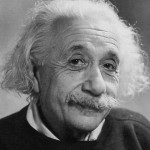
Einstein once said: “I was sitting in a chair in the patent office at Bern when all of the sudden a thought occurred to me: If a person falls freely, he will not feel his own weight. I was startled. This simple thought made a deep impression on me. It impelled me toward a theory of gravitation.”
This led Einstein to develop his general theory of relativity, which interprets gravity not as a force but as the curvature of space and time. This topic is out of the scope for our lesson here, but you can explore more about it in this lesson.
The fundamental principle for relativity is the principle of equivalence, which says that if you were locked up in a box, you wouldn’t tell the difference between being in a gravitational field and accelerating (with an acceleration value equal to g) in a rocket.
The same thing is also true if you were either locked in a box, floating in outer space or in an elevator shaft experiencing free-fall. Any experiments you could do in either of those cases wouldn’t be able to tell you what was really happening outside your box. The way a ball drops is exactly the same in either case, and you would not be able to tell if you were falling in an elevator shaft or drifting in space.
Please login or register to read the rest of this content.

Hang on… Now I see the problem, the link is broken! I’ll fix it asap.
Yes it is on the main page for circular motion. The answers are the last few pages. Enjoy!
Hi, loving HS physics! Is the link for the circular motion problem set ready yet?